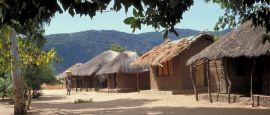Rising out of the surrounding plains and tea-growing Mulanje region, the massif is popular with hikers and climbers, and has several huts. The highest point of this huge block of mountains, which cover more than 640 sq km (250 sq miles), is Sapitwa Peak. At just over 3,000m (10,000ft), it is the country’s loftiest summit.
Malawi things to see and do
Tourist offices
Address: 4 Christian Fields, London, SW16 3JZ, Malawi
Tel: (0115) 982 1903.
www.malawitourism.com
In Malawi’s far south, the Lower Shire Valley has a very different look and feel. Low lying with higher temperatures, it is dominated by the River Shire. The only river to drain from Lake Malawi, it goes on to join the mighty Zambezi. A fertile region, there are vast sugar plantations to be seen at Sucoma.
View the many markets on the shore of Lake Malawi, including Nkhotakota, one of Africa's oldest market towns and a major centre of the Arab-Swahili slave trade until David Livingstone convinced Chief Jumbe to end the practice. Further north, Nkhata Bay is a busy port and market and a favourite with visitors for its lush tropical atmosphere.
Hike, mountain bike or ride a horse on the grassland of Nyika Plateau, where safaris on horseback are a popular activity. Fully encompassing Nyika National Park, the plateau is known for its wildlife, particularly Burchell’s zebra and endemic butterfly, bird and orchid populations. Accommodation and equipment hire is at Chelinda.
Due to its unspoiled environment and prolific game, Liwonde National Park is generally considered the best reserve in Malawi. Covering 550 sq km (212 sq miles) of thin woodland in the country’s south, wildlife includes large herds of elephant, hippos, lion, and a vast array of birds and antelope. Alternatively, look out for elephant and buffalo in Kasungu National Park.
Fishing, possible all year round on the southern lakeshore north of Mangochi and at Senga Bay, offers the opportunity to reel in ngumbo (yellow fish), mpasa (lake salmon) and ncheni (lake tiger) among other species. Trout fishing is easily arranged in the rivers and streams of the Nyika and Zomba Plateaus.
Capital of the northern region, Mzuzu reflects the culture of the Tumbuka, while remaining largely agricultural with tea, coffee and rubber plantations. Africa’s largest manmade forest lies to the south, and Nyika National Park and Vwasa Marsh Wildlife Reserve are nearby. The famous Livingstonia Mission, with its red brick homes and small museum, is approximately three hours away.
A range of watersports are available along the 580km (360 mile) length of Lake Malawi. Snorkelling and scuba-diving are increasingly popular because of the attraction of seeing the brilliantly coloured fish, the mbuna (African cichlids). Swimming, waterskiing, sailing and kayaking are all possible at various locations on the lakeshore.
Malawi's capital since 1975, Lilongwe was officially founded in 1906 as a colonial trading post. Alongside the traditional Old Town, with its interesting walled markets, is the modern New Town and seat of government with its imaginative architecture and beautiful garden setting. A short journey away is the famous pottery workshop at Dedza.
Malawi's commercial capital and largest town was established at the end of the 19th century. Sights include the National Museum on Chichiri Hill, St Michael and All Angels Church and its associated clock tower with its links to David Livingstone, and Mandala House. The oldest European building in Malawi, it dates back to 1882.
North of Blantyre, the 2,100m (6,890ft) Zomba Plateau offers spectacular views and fantastic walking, rock climbing and mountain biking. Its vast forests and waterfalls tower above Zomba, a university town and the former capital. Known for its colonial architecture and botanic gardens, the town is also home to a school of dressage.
Located near Malawi’s marine border with Mozambique, Likoma and its sister island Chizumulu offer a glimpse of largely unspoiled East African ocean and excellent swimming. The town of Mbamba is the site of the Saint Peter’s Anglican Cathedral. One of the largest churches in Africa, it was built by missionaries over a century ago.
Lake Malawi National Park lies towards the southern extremity of the lake near Monkey Bay. Snorkelling or scuba-diving reveals tropical fish, while inland antelope and vervet monkeys can be seen. An 800-year-old baobab tree in the park is reported to have been one of explorer David Livingstone’s favourite spots.
Traditional dances play a part in most ceremonies in Malawi. The Gule Wamkulu is an important dance performed by members of the Chewa tribe’s Nyau brotherhood, who cover themselves in carved masks, feathers and skin paint. It takes place following the July harvest, and also at weddings and funerals.
Do you have any Feedback about this page?
© 2026 Columbus Travel Media Ltd. All rights reserved. No part of this site may be reproduced without our written permission, click here for information on Columbus Content Solutions.








 You know where
You know where